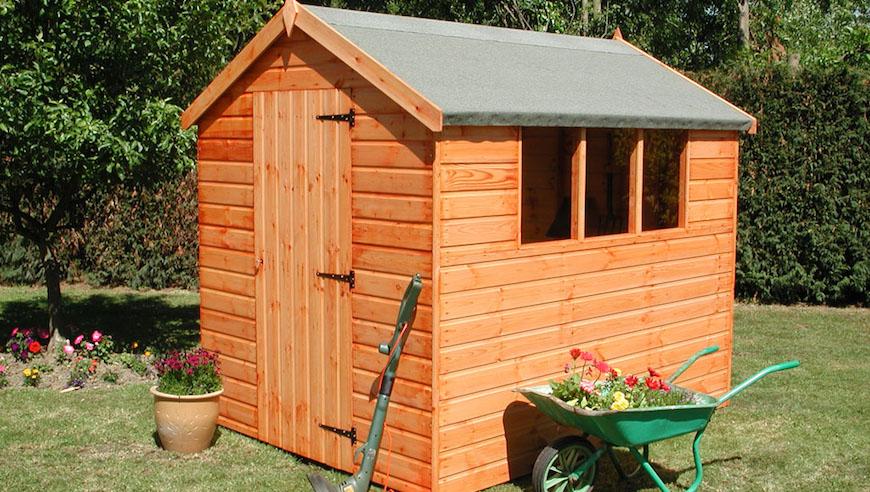Garden Shed Installation Cost
Last updated 16th September, 2025
Trying to find out how much it costs to build a shed? In this article, we look at shed assembly prices for different types and sizes of sheds. This makes it easy for anyone to calculate how much their new shed will cost them.

How Much to Build a Shed?
The average cost of getting a handyman to build a garden shed is typically around £600 for a 6x4 foot shed and it should take around 1-2 days to build.
A larger 12 x 8 foot shed on a solid concrete base will take 2 to 3 days to build and will cost on average around £1,200.
The cost of building a shed will depend on:
- Materials used.
- Design of the shed.
- How big it is.
- Whether a concrete foundation is needed.
- Where you live in the UK.
Below are some estimated costs of hiring a tradesman to build different shed sizes including laying a concrete foundation or concrete slabs:
Shed Assembly Prices
| Shed Size | Avg. Cost | Duration |
|---|---|---|
| 6ft x 4ft | £600 | 1-2 days |
| 8ft x 6ft | £800 | 1-2 days |
| 12ft x 8ft | £1100 | 1-2 days |
Table of Contents
Additional Costs
It's important to be clear with your handyman about what's included in the price and what you might need to pay for separately.
Usually, your shed building quote will include:
- Getting the shed materials delivered.
- Assembly of shed panels.
- Assembly of roof and installation of felt.
- Securing the shed to its base.
- Basic weatherproofing.
- Removal of any packaging.
If a concrete foundation needs to be laid for your new garden shed, this will typically be quoted on separately. Be sure to check this with your handyman to ensure you're both clear on what the final bill will be.
There may be other jobs you choose to have done at the same time as installing your new shed. The cost of these will generally be considered separately, although your handyman may be able to bundle some of them together to save on labour costs.
Removing Old Shed
Gardens that already have a shed will need to budget for removal.
The average cost to remove a shed is around £350. However, you may be able to bundle this in with your handyman's quote for building your new shed.
Garden Clearance
Gardens that are in a bit of a mess may need some work before the shed can be installed.
This can have several benefits:
- Allows easier access for the shed installation.
- Ensures weeds and plants don't damage the new shed.
- Offers a clean slate for the garden.
Garden clearance is something you can do yourself if you're looking to save money or you can hire someone to help.
The cost of removing garden waste will depend on how much there is. Again, this may be something you can handle yourself or you may need a handyman or company to assist.
Painting and Treatment
The average garden shed installation cost doesn't usually include painting or treatment.
If you want your shed painted in a way that suits your property, you'll need to factor this into your overall budget.
Similarly, wooden sheds may require treatment to protect them from the elements. This can save you money in the long run by prolonging the shed's lifespan, so it's worth considering shed treatment when you first install the shed.
Insulation
If you're going to spend a lot of time in your shed or it's storing items that you want to protect, you may want to consider insulation.
This can installed on a DIY basis or your handyman may be able to add this to your garden shed cost.
Guttering
Installing guttering on your shed could prolong its lifespan by ensuring water drains away properly and doesn't pool on the shed roof.
Guttering costs for sheds will depend on who you choose to do the job. This is something a handyman could easily handle, and there is generally no need to hire a professional roofer (unless you're getting your house guttering replaced at the same time).
Electrics
If you plan on using the shed as a workshop or office, you’ll probably need to have mains power installed.
While it may be tempting to use extension leads plugged into a power socket inside the home, this is dangerous and it's much safer to have a professional installation if you're going to regularly require electricity in your shed.
You will require a professional electrician to install safe and weatherproof power. On average, electrician prices are between £35 and £55 per hour, although they will often have minimum fees for smaller jobs.
Cost Breakdown
Individual costs for fitting an 8ft x 6ft garden shed - Total Cost: £800
Materials
£520
Tradesmen
£280
Waste Removal
£0
Labour Cost To Build a Shed
Your overall garden shed cost will be affected by the cost of labour.
Tradesmen often charge around £150 to £200 per day.
Even if putting up a garden shed takes less than a day, you will still likely pay a minimum rate of around £100 for labour. This ensures that the handyman is getting a fair rate for their labour.
Where you live in the UK will also affect the cost of building a shed. Costs will be higher in London and the South East, so be sure to work this into your budget.
How Long Will It Take To Build a Shed?
It will typically take around 1 to 2 days to install a new garden shed.
However, more complex shed designs may take longer, and extra time may be needed if the shed requires a solid foundation to be built. This is often a few inches of cement or concrete slabs but it adds to the installation time.
What To Consider Before Building a Garden Shed
Garden sheds are a great way of keeping your garden equipment and tools safe and secure, but can also serve as a summerhouse, a workshop or even an office.
Garden sheds are practical and useful additions to your garden, helping you to make the most of the way you use your outdoor space.
In order to choose the right shed to fit your requirements, you need to consider what size of shed you need, consider what you’re going to store in it and how you are going to use it.
It’s best to measure the space you have available for a shed in your garden before buying, but if in any doubt, opt for a slightly larger shed, too much space is always better than too little.
The majority of sheds require assembly on site and you’ll usually need at least two people to build a shed up safely. All sheds require a foundation or base that is sound and level.
Make sure you don’t place the shed too close to any fence or walls, and leave enough space to paint/treat/stain the timber to prevent rot.
The most important consideration when choosing a garden shed is the size, this of course is often dictated by the size of your garden and the available space, but always try to buy the largest shed possible. The main reason is that you will quickly find that the garden shed will soon fill up with all the stuff you have and over the years you will no doubt collect more, pretty soon the shed will be full of clutter making it difficult to access the tools you need.
Unlike other garden buildings, a garden shed or workshop is best placed out of the sun so that it does not get too hot.
Another tip for finding a good location is to place the door of the shed near the garden path to avoid traipsing mud into the shed during bad weather. Try and avoid having trees or shrubs overhanging your new shed if possible as this can cause leaks or damp over time. If this cannot be avoided, then the addition of gutters can help.
If you can, always raise the shed up off the ground and allow air to circulate underneath the floor.
What Are Garden Sheds Made From?
Garden sheds are usually either wooden or metal, though plastic is becoming more popular.
Metal sheds are easy to assemble, more secure, and can come in an array of pre-painted colours. If installed correctly a metal shed can do the same job as a wooden one, often at a lower cost over the years due to the little maintenance required.
On the other hand, wooden sheds are usually more aesthetically pleasing, cheaper to buy initially and warmer.
Plastic sheds are cheap and much lighter than wooden and metal sheds, which makes them easy to move around. On the downside, it also makes it much easier for them to blow around in high winds!










